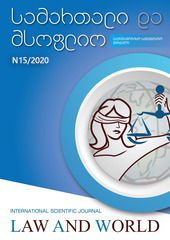აფექტირებული დანაშაულის ესკიზი საერთო სამართლის ქვეყნებში 
##plugins.themes.bootstrap3.article.main##
ანოტაცია
● In common law countries, which as a rule do not have codified criminal legislation, or where it exists, offences committed under the provoked temporary insanity are not treated as a separate type of wrongdoing (delictum sui generis). Criminal theory and practice considers them as a particular example of privileged homicide related to manslaughter but not the murder. ● Actus reus of offences committed under the provoked temporary insanity (as a kind of privileged homicide) consists of following objective elements: a) conduct, result (i.e. death), causal link between them and any other facultative element; b) provocative behavior committed by the victim; c) causal link between the victim’s behavior and the perpetrators provoked conduct (double causation). ● Mens rea of the offences in question pertains to both subjective elements characteristic to manslaughter: a) recklessness and b) extreme temporary emotional excitement, which might be either explained or justified on rationale basis. The verification of rationality depends on the “reasonable man” standard and how would he behave in the same situation. ● As a starting point, for the classification of mental element traditionally is applied M’Naghten case. Although it focuses on the perpetrator’s capacity to understand wrongfulness of conduct, to be responsible for his crimes, it can be directly applied to the offences, committed under the provoked temporary insanity considered as a serious situational disorder of activity of psychic or state of mind. ● Legal regulation of an offences committed under the provoked temporary insanity is entirely differently constructed within the common law countries in comparison with other legal systems, including Georgian Penal Code. The common law approach is hard to be considered as a successful one, as it is not always efficient in terms of theoretical and practical considerations. ● The main shortcoming of common law system is related to its ambiguity, derived from abundance of value judgments, tests, fictions and criteria.
##plugins.themes.bootstrap3.article.details##
როგორ უნდა ციტირება

ეს ნამუშევარი ლიცენზირებულია Creative Commons Attribution-ShareAlike 4.0 საერთაშორისო ლიცენზიით .





